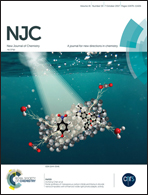Negative hyperconjugation effect on the reactivity of phosphoramide mustard derivatives as a DNA alkylating agent: theoretical and experimental insights†
Abstract
In an effort to identify the factors that affect the reactivity of nitrogen mustards, we prepared two phosphoramide mustard derivatives in interaction with DNA. The activity of these drugs was compared to that of cyclophosphamide and phosphoramide mustard. The effect of drug interaction on DNA aggregation and condensation was investigated in aqueous solution under physiological conditions, using a constant DNA concentration (6.25 mM) and various ligand/polynucleotide (phosphate) ratios of 1/160, 1/80, 1/40, 1/20, 1/10, 1/5, 1/2, and 1/1. Fourier transform infrared, two-dimensional infrared (2D IR), and ultraviolet (UV)-visible spectroscopic methods were used to determine the ligand binding modes, the binding constants, and the stability of the drug–DNA complexes in aqueous solution. Density functional theory (DFT) calculations followed by a natural bond orbital (NBO) analysis, Fukui functions, electron localization functions (ELF), generalized valence bond (GVB) calculations, and quantum theory of atoms in molecules (QTAIM) were used to find the relationship between the structure and reactivity of phosphoramide mustard derivatives. Together with these methods, docking studies were applied to understand the features that dominate the molecular orbitals, charges, and other binding parameters. Theoretical results that coincided with the experimental values were obtained under similar conditions of pH and temperature. The results showed that the reactivity of these compounds is controlled by the frontier molecular orbitals, as well as the factors affecting them, such as negative hyperconjugation.



 Please wait while we load your content...
Please wait while we load your content...